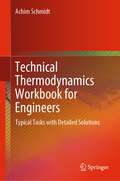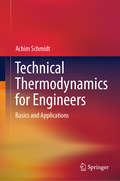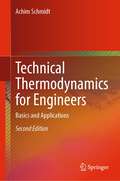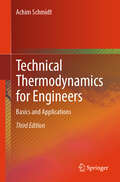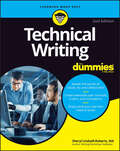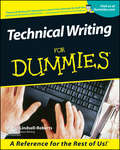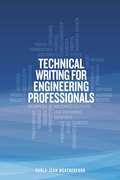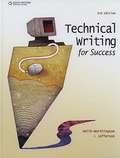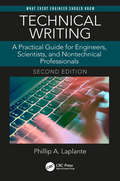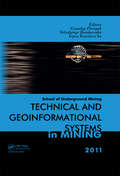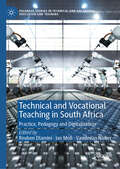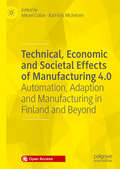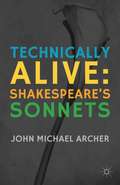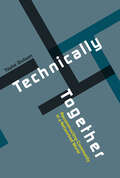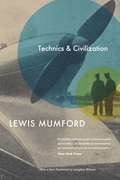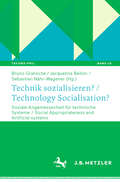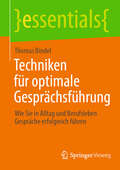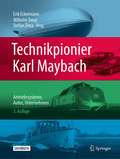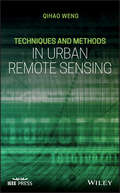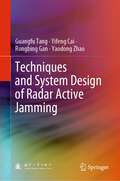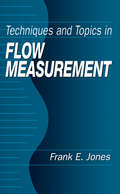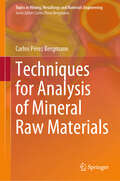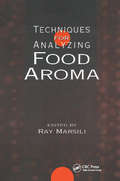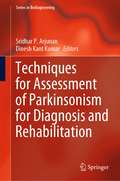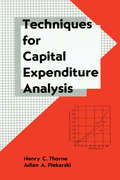- Table View
- List View
Technical Thermodynamics Workbook for Engineers: Typical Tasks with Detailed Solutions
by Achim SchmidtThis book offers a comprehensive collection of typical tasks from technical thermodynamics. It is ideal for preparing written and oral examinations at university. It contains 180 tasks that are solved in detail. Alternative solution strategies are often shown and discussed. The book is interesting for all engineering students who have to take an exam in thermodynamics. A problem-orientated approach is followed and a systematic method for solving the tasks is developed. Theoretical correlations and thermodynamic fundamentals are solved by means of concrete tasks. In addition to comprehension questions, the book contains numerous typical calculation problems. Here, too, the basics are summarised and solutions respectively solution strategies are discussed. These are conceived to provide students with strategies and tools to solve complex tasks. All these exercises should help to deepen the physical knowledge. The greater the technical competence, the more confidently one can face the exam! At best, the tasks will help you to have fun and enjoy thermodynamics! This book is a perfect complement to my textbook "Technical Thermodynamics for Engineers".
Technical Thermodynamics for Engineers: Basics and Applications
by Achim SchmidtThermodynamics is a subject that all engineering students have to face and that most of them treat with great respect. This makes it all the more important to offer a good and easy-to-understand approach to the laws of energy conversion. This is what this textbook is intended to do: It covers the basics of classical technical thermodynamics as they are typically taught at universities: The first and second law of thermodynamics as well as equations of state are explained for idealized and real fluids which are subject to a phase change. Thermodynamic mixtures, e.g. humid air, are treated as well as chemical reactions. Components and thermodynamic cycle that convert energy are presented. The book attaches great importance to drawings and illustrations, which should make it easier to comprehend complex matter. Technical applications and apparatus are presented and explained. Numerous exercises and examples conclude the book and contribute to a better understanding of the theory.
Technical Thermodynamics for Engineers: Basics and Applications
by Achim SchmidtThe book covers the classical areas of technical thermodynamics: The first part deals with the basic equations for energy conversion and idealized fluids. The second part deals with real fluids, which can be subject to a phase change, for example. Furthermore, thermodynamic mixtures of fluids are considered, e.g., humid air and gas mixtures. In the last part of the book, combustion processes and chemical reactions are presented and thermodynamically balanced. In each chapter, there are examples and exercises to deepen the theoretical knowledge. Compared to the first edition, the topic of thermodynamic state diagrams has been greatly revised. State diagrams of relevant refrigerants have been added as well as a formulary. The section on chemically reacting systems has been expanded and thoroughly revised. In the basic chapters, tasks and examples have been added to consolidate the understanding of the subject. The book is aimed at students of mechanical engineering and professional engineers.
Technical Thermodynamics for Engineers: Basics and Applications
by Achim SchmidtThis book covers the classical areas of technical thermodynamics: The first part deals with the basic equations for energy conversion and idealized fluids. The second part deals with real fluids, which can be subject to a phase change, for example. Furthermore, thermodynamic mixtures of fluids are considered, e.g., humid air and gas mixtures. In the last part of the book, combustion processes and chemical reactions are presented and thermodynamically balanced. In each chapter, there are examples and exercises to deepen the theoretical knowledge. In this third edition of the textbook, a chapter on thermodynamics of mixtures has been added. This includes both gas and liquid mixtures, which are considered ideal and real. Equilibrium conditions and state functions are derived step by step and discussed using the example of binary mixtures. The book is aimed at students of mechanical engineering and professional engineers.
Technical Writing For Dummies
by Sheryl Lindsell-RobertsLearn to document the technology that makes the world go Technical Writing For Dummies is a master class on how to build a career writing user manuals, e-learning, streaming, simulations, and more. It even zooms into the metaverse. Whether you’re new to the field, a seasoned professional, or a technical person who needs to write, this guide arms you with the skills you need to cash in on this flourishing world of technical writing. This isn’t your average how-to. It’s a compendium of innovative industry knowledge that will help you set yourself apart with the latest trends and best practices in technical writing. As a tech writer, you’ll need a robust skillset that allows you to offer clear and concise documentation for just about anything. This new edition of Technical Writing For Dummies—updated for all of today’s tech writing advances—can get you there. Uncover the basics of technical writing and master common documentation types Get insight into the career paths available to tech writers today Discover new remote collaboration options and cloud-based tools for technical writers Learn how to elevate your documents for high search engine optimization (SEO) rankings Improve your craft to connect with diverse, global audiencesWhether you’re a technical writer or technical professional who needs to write—you can learn the best practices of effective technical writing, as well as how to navigate its various formats and platforms, thanks to this handy Dummies guide.
Technical Writing For Dummies (For Dummies Ser.)
by Sheryl Lindsell-RobertsLet’s face it, a lot of technical documentation reads as if it had been translated into English from Venutian by a native speaker of gibberish. Which is annoying for you and expensive for the manufacturer who pays with alienated customers and soaring technical support costs. That’s why good technical writers are in such big demand worldwide. Now, Technical Writing For Dummies arms you with the skills you need to cash in on that demand. Whether you’re contemplating a career as a technical writer, or you just got tapped for a technical writing project, this friendly guide is your ticket to getting your tech writing skills up to snuff. It shows you step-by-step how to: Research and organize information for your documents Plan your project in a technical brief Fine-tune and polish your writing Work collaboratively with your reviewers Create great user manuals, awesome abstracts, and more Write first-rate electronic documentation Write computer- and Web-based training courses Discover how to write energized technical documents that have the impact you want on your readers. Wordsmith Sheryl Lindsell-Roberts covers all the bases, including: All about the red-hot market for technical writing and how to get work as a technical writer The ABCs of creating a strong technical document, including preparing a production schedule, brainstorming, outlining, drafting, editing, rewriting, testing, presentation, and more Types of technical documents, including user manuals, abstracts, spec sheets, evaluation forms and questionnaires, executive summaries, and presentations Writing for the Internet—covers doing research online, creating multimedia documents, developing computer-based training and Web-based training, and writing online help Combining examples, practical advice, and priceless insider tips on how to write whiz-bang technical documents, Technical Writing For Dummies is an indispensable resource for newcomers to technical writing and pros looking for new ideas to advance their careers.
Technical Writing for Engineering Professionals
by Darla-Jean WeatherfordTechnical Writing for Engineering Professionals provides a toolkit for developing technical reports quickly and efficiently. The book offers clear, specific guidelines for developing each of the sections (abstract, conclusions, introduction, and discussion) and designing and using graphics that illustrate your results. Weatherford's approach can be applied in all types of writing, from email and letters to project proposals and final reports. The book also includes tips for using English that will help keep your writing crisp and clear. Anyone in a technical profession, from intern to management, who wants to implement a better, faster, and more consistent approach to writing will benefit from reading this book. Key Features -Understand the process of writing a technical report, from the time you know your conclusions until you present it to your supervisor, client, or professional organization. -Get a quick overview of each chapter in the "short form" summary at the beginning, and use the handy checklist at the end to critique each part of your report as you write. -Learn to read literature efficiently and critically and take notes that will help you write your own reports as well as how to cite material that will lend strength to your work.
Technical Writing for Success
by Darlene Smith-Worthington Sue JeffersonTaking an applied approach to teaching workplace writing, TECHNICAL WRITING FOR SUCCESS 3E is a comprehensive text designed to focus on skills that employers demand in today's workplace--thinking, listening, composing, revising, and editing. Students are encouraged to acquire many workplace skills through integrated and applied instruction so that mastering technical writing is relevant and exciting. Abundant model documents reflect Office 2007 formats and include questions providing critical thinking opportunities. This comprehensive text features an engaging writing style, student and real-world models, write-to-learn activities, expanded oral presentation coverage, and much more. TECHNICAL WRITING FOR SUCCESS 3E provides instruction on the less common documents not covered in general communication texts, e. g. , proposals, news releases, science lab reports, and instructions. Chapter contents include technical research; writing for the Web; brief informative, brief investigative and recommendation reports; as well as technical reading.
Technical Writing: A Practical Guide for Engineers, Scientists, and Nontechnical Professionals, Second Edition (What Every Engineer Should Know)
by Phillip A. LaplanteEngineers, scientists, and professionals of all types are often required to write reports, summaries, manuals, and guides. While many have had an English language or writing course, it is less likely that they have had instruction in the special requirements of technical writing. Filling this void, Technical Writing: A Practical Guide for Engineers, Scientists, and Nontechnical Professionals, Second Edition enables readers to write, edit, and publish materials of a technical nature, including books, articles, reports, and electronic media. Written by a renowned engineer and widely published technical author, this guide complements traditional writer’s reference manuals on technical writing through presentation of first-hand examples that help readers understand practical considerations in writing and producing technical content. These examples illustrate how a publication originates as well as various challenges and solutions. The second edition contains new material in every chapter including new topics, additional examples, insights, tips and tricks, new vignettes and more exercises. Appendices have been added for writing checklists and writing samples. The references and glossary have been updated and expanded. In addition, a focus on writing for the nontechnical persons working in the technology world and the nonnative English speaker has been incorporated. Written in an informal, conversational style, unlike traditional college writing texts, the book also contains many interesting vignettes and personal stories to add interest to otherwise stodgy lessons. Key Features •Offers precise, hands-on coverage of technical writing •Complements traditional writer’s reference manuals •Includes personal anecdotes and historical stories that serve as real-world examples of technical writing •Explores the various avenues for publishing your work •Explains how to write for blogs, social networks, and other e-media
Technical and Geoinformational Systems in Mining: School of Underground Mining 2011
by Genadiy Pivnyak Volodymyr Bondarenko Iryna Kovalevs’kaNew trends of mineral deposits mining in the world consist of intensifying and concentration of mining operations. This is achieved with the help of new technical equipment that is more reliable, having greater service life and more available power. Consideration is given to quantity reduction of stopes and development workings together with t
Technical and Vocational Teaching in South Africa: Practice, Pedagogy and Digitalisation (Palgrave Studies in Technical and Vocational Education and Training)
by Reuben Dlamini Ian Moll Vasidevan NaikerThis book unpacks the notion of pedagogy in South African technical and vocational education and training (TVET), enhancing the importance of the psychological dimension of learning. The book is premised on the idea that as stories of actual, grounded teaching and learning practices emerge from South African colleges, a coherent picture of pedagogy can be established. With chapters by practising TVET educators writing about their own work, the volume seeks to reconceptualise vocational teaching and learning processes with diversity and inclusivity in mind. The book will be of interest to students and scholars of TVET and education in South Africa, as well as South African college practitioners and policymakers.
Technical, Economic and Societal Effects of Manufacturing 4.0: Automation, Adaption and Manufacturing in Finland and Beyond
by Mikael Collan Karl-Erik MichelsenThis open access book is among the first cross-disciplinary works about Manufacturing 4.0. It includes chapters about the technical, the economic, and the social aspects of this important phenomenon. Together the material presented allows the reader to develop a holistic picture of where the manufacturing industry and the parts of the society that depend on it may be going in the future. Manufacturing 4.0 is not only a technical change, nor is it a purely technically driven change, but it is a societal change that has the potential to disrupt the way societies are constructed both in the positive and in the negative.This book will be of interest to scholars researching manufacturing, technological innovation, innovation management and industry 4.0.
Technically Alive
by John Michael ArcherDrawing on the later writings of Martin Heidegger, the book traces the correspondence between the philosopher's concept of technology and Shakespeare's poetics of human and natural productivity in the Sonnets.
Technically Together: Reconstructing Community in a Networked World
by Taylor DotsonWhy we should not accept “networked individualism” as the inevitable future of community. If social interaction by social media has become “the modern front porch” (as one sociologist argues), offering richer and more various contexts for community and personal connection, why do we often feel lonelier after checking Facebook? For one thing, as Taylor Dotson writes in Technically Together, “Try getting a Facebook status update to help move a couch or stay for dinner.” Dotson argues that the experts who assure us that “networked individualism” will only bring us closer together seem to be urging citizens to adapt their social expectations to the current limits of technology and discouraging them from considering how technologies could be refashioned to enable other ways of relating and belonging. Dotson characterizes different instantiations of community as “thick” or “thin,” depending on the facets and manifestations of togetherness that they encompass. Individuating social networks are a form of community, he explains, but relatively thin in regard to several dimensions of communality. Dotson points out that current technological practices are not foreordained but supported by policies, economic arrangements, and entrenched patterns of thought. He examines a range of systems, organizations, and infrastructures—from suburban sprawl and smartphones to energy grids and “cry-it-out” sleep training for infants—and considers whether they contribute to the atomization of social life or to togetherness and community vibrancy. Dotson argues that technology could support multifaceted communities if citizens stopped accepting the technological status quo and instead demanded more from their ever-present devices.
Technics and Civilization
by Lewis Mumford Langdon WinnerTechnics and Civilization first presented its compelling history of the machine and critical study of its effects on civilization in 1934--before television, the personal computer, and the Internet even appeared on our periphery. Drawing upon art, science, philosophy, and the history of culture, Lewis Mumford explained the origin of the machine age and traced its social results, asserting that the development of modern technology had its roots in the Middle Ages rather than the Industrial Revolution. Mumford sagely argued that it was the moral, economic, and political choices we made, not the machines that we used, that determined our then industrially driven economy. Equal parts powerful history and polemic criticism, Technics and Civilization was the first comprehensive attempt in English to portray the development of the machine age over the last thousand years—and to predict the pull the technological still holds over us today.
Technik sozialisieren? / Technology Socialisation?: Soziale Angemessenheit für technische Systeme / Social Appropriateness and Artificial Systems (Techno:Phil – Aktuelle Herausforderungen der Technikphilosophie #10)
by Bruno Gransche Jacqueline Bellon Sebastian Nähr-WagenerAnwendungen Künstlicher Intelligenz, Maschinellen Lernens sowie Robotik und weitere informatische Systeme spielen in immer mehr Bereichen der menschlichen Lebenswelt eine immer wichtigere Rolle. Technik wird dabei auch weiterhin und zunehmend Medium menschlicher Kommunikation und Interaktion sein, darüber hinaus wird jedoch auch immer mehr menschliche Interaktion nicht nur durch sondern mit Technik stattfinden. Eine Dimension neuer Mensch-Technik-Relationen ist dabei das Phänomen sozialer Angemessenheit. Obgleich sich dieses nicht auf ein einfaches Regelwerk reduzieren lässt, verhalten sich Menschen in zwischenmenschlicher Interaktion ganz selbstverständlich sozial angemessen und treffen in der Regel ohne Weiteres ‚den richtigen Ton‘. Wie aber verhält es sich mit ‚intelligenten‘ technischen Systemen? Können – sollten – diese mit Fähigkeiten zu entsprechendem Sozialverhalten ausgestattet werden, um damit auch eine weitere bedeutsame Grenze zwischen Mensch und Technik zum Verschwinden zu bringen? Anders gefragt: Ist es möglich und erforderlich, Technik zu sozialisieren?
Techniken für optimale Gesprächsführung: Wie Sie in Alltag und Berufsleben Gespräche erfolgreich führen (essentials)
by Thomas BindelThomas Bindel schlägt Ihnen vor, mit welchen Worten Sie in schwierigen Situationen richtig reagieren. Er verrät Ihnen, mit welcher Systematik Sie Gespräche und Verhandlungen perfekt vorbereiten. Und er zeigt Ihnen, wie Sie mit Menschen vertieft ins Gespräch kommen, indem Sie besser zuhören und treffende Fragen stellen. Das vorliegende Buch bietet somit ein Konzentrat aus den wichtigsten Methoden, um Gespräche optimal führen zu können: Ausgestattet mit dem Erfolgsprinzip eines amerikanischen Präsidenten, diversen Denkhüten, passenden Strategien und Techniken für Gesprächsvorbereitung, -führung sowie -nachbereitung übersteht man die Begegnung mit dem Freud&’schen Eisberg und findet so zu einer Kommunikation, die durch ein Quadrat runder läuft und gewaltfrei mehr erreicht.
Technikpionier Karl Maybach: Antriebssysteme, Autos, Unternehmen
by Hartmut Seeger Alfred Gottwaldt Erik EckermannViele Bücher dokumentieren die glanzvolle Zeit der Zeppeline. Eingebettet in die Weltkriegswirren der ersten Hälfte des 20. Jahrhundert, symbolisieren die großen Zeppeline noch heute technologischen Fortschritt und die Hoffnung auf eine besser vernetzte Welt. Weit weniger ist hingegen über die Männer hinter dem Zeppelinbau, die Baugeschichte und die Auswirkungen auf die heutige Mobilität bekannt. Wilhelm Treue und Stefan Zima haben das Wirken von Wilhelm und Karl Maybach unter diesen Aspekten zusammengestellt. Mit der aktuellen Auflage hat Erik Eckermann den Einfluss auf den Motorenbau zwischen den 60er Jahren bis heute ergänzt und mit einem besonderen Blick auf den Automobilbau erweitert.
Techniques and Methods in Urban Remote Sensing
by Qihao WengAn authoritative guide to the essential techniques and most recent advances in urban remote sensing Techniques and Methods in Urban Remote Sensing offers a comprehensive guide to the recent theories, methods, techniques, and applications in urban remote sensing. Written by a noted expert on the subject, this book explores the requirements for mapping impervious surfaces and examines the issue of scale. The book covers a range of topics and includes illustrative examples of commonly used methods for estimating and mapping urban impervious surfaces, explains how to determine urban thermal landscape and surface energy balance, and offers information on impacts of urbanization on land surface temperature, water quality, and environmental health. Techniques and Methods in Urban Remote Sensing brings together in one volume the latest opportunities for combining ever-increasing computational power, more plentiful and capable data, and more advanced algorithms. This allows the technologies of remote sensing and GIS to become mature and to gain wider and better applications in environments, ecosystems, resources, geosciences, geography and urban studies. This important book: Contains a comprehensive resource to the latest developments in urban remote sensing Explains urban heat islands modeling and analysis Includes information on estimating urban surface energy fluxes Offers a guide to generating data on land surface temperature Written for professionals and students of environmental, ecological, civic and urban studies, Techniques and Methods in Urban Remote Sensing meets the demand for an updated resource that addresses the recent advances urban remote sensing.
Techniques and System Design of Radar Active Jamming
by Guangfu Tang Yifeng Cai Rongbing Gan Yaodong ZhaoThis book serves as a handbook for radar active jamming system designers, in which design principles and methods are introduced in detail. The book starts from the basic concept and then discusses requirements analysis, type selection, key indicators description, and design methods of radar active jamming system and each subsystem step by step. The content is expressed in an intelligible way, and hence, it is easy to follow even for beginners in this area. Since the authors of this book are all experts and have designed plenty of real systems, their book certainly helps new engineers deal with different kinds of problems encountered while designing a radar active jamming system.
Techniques and Topics in Flow Measurement
by Frank E. JonesTechniques and Topics in Flow Measurement covers the applications and techniques of flow measurement. This definitive book provides guidelines for choosing appropriate techniques and assuring valid measurements as well as describes methods for treatment of calibration data in fluid flow under various conditions. The book also covers three systems of units: the SI system, the English Absolute Dimensional system, and the English Engineering system. Commonly used - and often misused - variables such as force, weight, and pressure are defined, and the relationships between the systems for these common variables are summarized.One of the many unique features of Techniques and Topics in Flow Measurement is the number of ready-to-use tables included throughout the text. Tables are provided for such commonly encountered variables as the saturation vapor pressure of water; the composition of dry air; the compressibility factor for air; air-free and air-saturated water density; viscosity of dry air, nitrogen, and other gases; and specific heat/specific volume ratios for dry air, water vapor, and moist air. Another unique feature of this book is the number of highly relevant examples. The author includes examples/exercises that demonstrate applications for density calculations; water vapor mixing ratio determination; gas viscosity interpolation; NIST guideline applications; buoyancy corrections; and more.
Techniques for Analysis of Mineral Raw Materials (Topics in Mining, Metallurgy and Materials Engineering)
by Carlos Pérez BergmannThis book presents a comprehensive exploration of fundamental concepts crucial for assessing the industrial viability of raw materials. Each chapter delves into a phenomenological understanding of various techniques, placing practical insights at the forefront while minimizing reliance on complex mathematical formalism. While recognizing the importance of select mathematical formulations to underpin the underlying physical principles, the primary emphasis remains on accessibility and real-world applicability. Readers will gain a solid understanding of pivotal concepts, equipping them with the proficiency to articulate the symbiotic relationship between analytical techniques and the acquisition of commercially significant insights.
Techniques for Analyzing Food Aroma: Food Aroma (Food Science And Technology Ser. #79)
by Ray MarsiliCovers important methods and recent developments in food-aroma analysis. The text discusses the problem-solving capabilities of analytical methods for food flavours and aromas, showing how to select appropriate techniques for resolving the problems of major food trends. It includes a treatment of off-flavour and malodor analyses and new polymer sensor array instruments.
Techniques for Assessment of Parkinsonism for Diagnosis and Rehabilitation (Series in BioEngineering)
by Sridhar P. Arjunan Dinesh Kant KumarThis book describes the range of technologies that have been developed for diagnosing and assessing Parkinson’s disease patients. Also presenting the latest studies providing insights into the changes to the neural system in Parkinson’s disease, it is a valuable resource for neurologists, general practitioners and nurses. Further, the book highlights areas that require more research, and as such will appeal to researchers, biomedical engineers and clinicians.
Techniques for Capital Expenditure Analysis (Cost Engineering)
by Henry C. Thorne Julian A. PiekatskiThis work examines the most important techniques for analyzing the profitability of capital investments. It discusses time value mechanics and financial concepts, including discounted cash flow, return on investment, incremental analysis, cash flow tables, income taxes, depreciation, cost of capital and risk analysis. It provides a broad introduction to project evaluation and data needs.;This book is intended for: cost, project, design, mechanical, chemical, industrial,electronic,electrical and construction engineers; project and budget managers; cost estimators and controllers; planners and schedulers; and upper-level undergraduate and graduate students in these disciplines.
